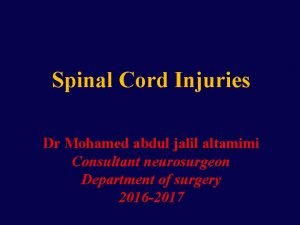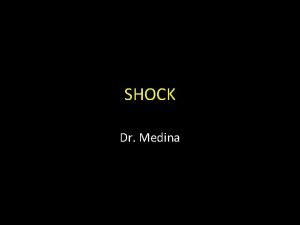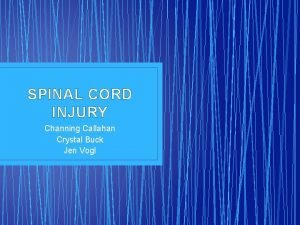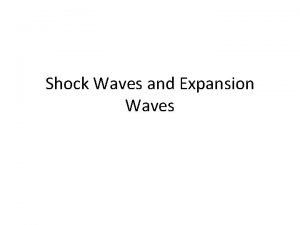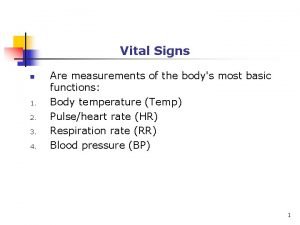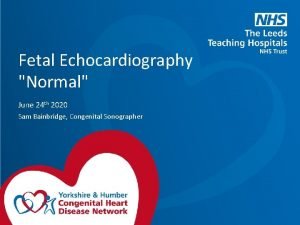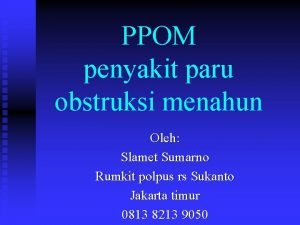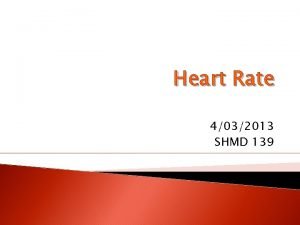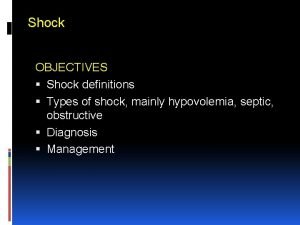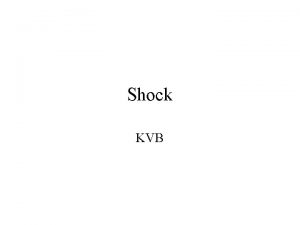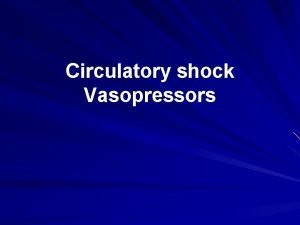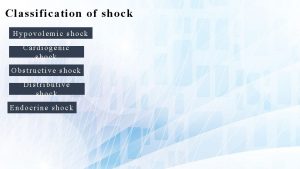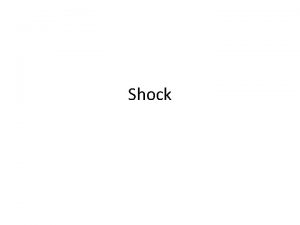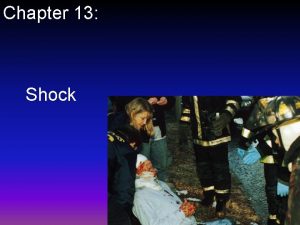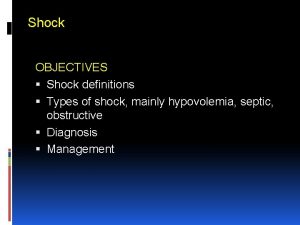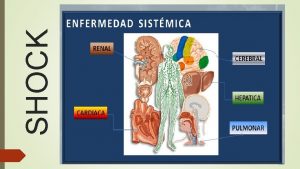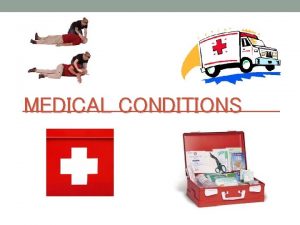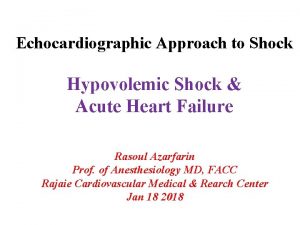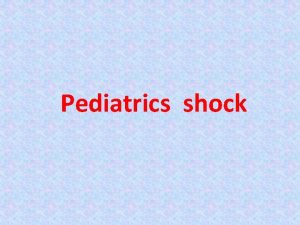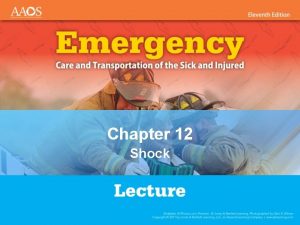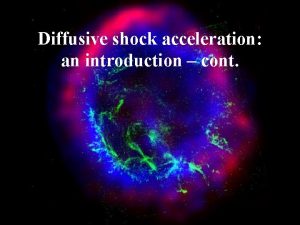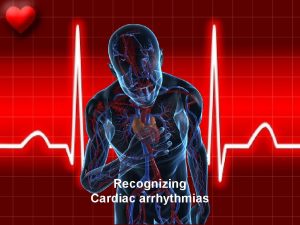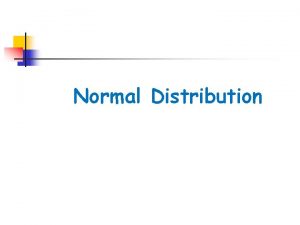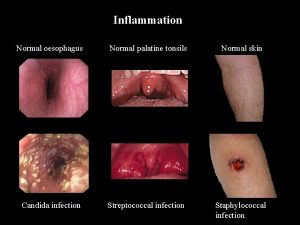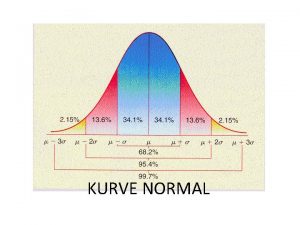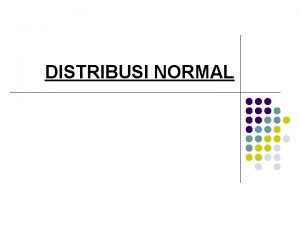Shock Introduction n In normal conditions the heart




























- Slides: 28

Shock

Introduction n In normal conditions, the heart generates power and it does so in an extremely efficient manner. n This power is used to deliver nutrients to and remove waste products from metabolizing tissues. n Failure of the heart to carry out these functions will lead to shock state.

Definition n Shock is a state of inadequate tissue perfusion. n The reduction in oxygen delivery will lead to anaerobic metabolism and metabolic acidosis. n Compensatory mechanisms attempt to maintain perfusion to vital organs. n If adequate circulation is not rapidly restored MOF and death may occur.

Circulatory homeostasis n Preload: - The majority of the blood during rest is in the venous system. - return of this venous blood to the heart will produce (VEDV) a major determinant of CO n Afterload: - is the force acting to resist myocardial work during contraction - arterial pressure is the major component (vascular resistance) that influince the EF

Stages / Spectrum of Shock n “Preshock” /compensated/warm shock - body is able to compensate for ↓perfusion - up to ~10% reduction in blood volume - tachycardia to ↑cardiac output & perfusion n “Shock” - compensatory mechanisms overwhelmed - signs/symptoms of organ dysfunction - ~20 -25% reduction in blood volume n “End-organ dysfunction” - leading to irreversible organ damage/death

Physiologic Determinants n Global tissue perfusion is determined by: n Cardiac output (CO) n Systemic vascular resistance (SVR)

Types of shock n Hypovolemia: (↓ preload)/ inadequate blood flow ) - dehydration - haemorrhage - burns - sepsis n Cardiogenic: (pump failure or ↓SV) - myocardial infarction/ischemia - valvular disruption - myocardial rupture

Types of shock n Mechanical/obstruction: Obstructed blood flow either into or out of the heart - pulmonary embolism - cardiac tamponade - tension pneumothorax n Distributive (vasodilatory) shock: blood flow and volume - neurogenic shock - septic shock - anaphylaxis - addisonian crisis (↓SVR) / Inappropriately distributed

Common Features of Shock n Hypotension (not an absolute requirement) - SBP < 90 mm Hg, not seen in “preshock” n Cool, clammy skin - Vasoconstrictive mechanisms to redirect blood from periphery to vital organs - Exception is warm skin in early distrib. Shock n Oliguria (↓kidney perfusion) n Altered mental status (↓brain perfusion) n Metabolic acidosis

Summary of management of shock state GOAL Restore tissue perfusion and oxygenation Ensure oxygenation and ventilation optimize haemodynamic status Adequate airway 100% oxygen Intubate and ventilate If necessary optimize ventricular filling optimize cardiac output support BP treat underlying cause control bleeding control sepsis treat MI GOAL Prevent complications (metabolic acidosis, coagulopathy, renal failure, MOF and death

Continue n Treat on basis of physiologic abnormality: Hypovolemic shock * search for and treat underlying cause * gain vascular access * give IVF * treat pain, hypothermia and acidemia septic shock * treat as in hypovolemia * search for and treat underlying cause after initial resuscitation neurogenic shock * treat as in hypovolemia * place in Trendelenberg‘s position * use vasoconstrictors as necessary cardiogenic shock * diuresis if EDV is high * control hypertension * initiate beta-blockade in most cases * maintain Hb>10 g/dl * search for and treat underlying cause

Hypovolemic shock n Most common cause of shock in surgical patients n Causes: - blood loss - plasma loss ( burns, anaphylaxis, sepsis ) - extracellular fluid loss ( GI loss, 3 d space loss )

Hypovolemic shock n The priority in the management is to restore CO and BP n Vascular access n Fluid challenge: - 500 ml RL or NS/5 -10 min or 20 ml/kg (1 -2 times) - assess CVP and BP pre and post

Compressive shock n cause: compression of the following by external forces: - chambers of the heart (the atria and left ventricle) the great veins (systemic or pulmonary) the great arteries (systemic or pulmonary) - any combination of these. n Outcome: decrease ventricular production of both pressure and flow

Compressive shock n Clinical conditions: - pericardial tamponade - tension pneumothoraces - positive pressure ventilation with large tidal volumes or high airway pressures - elevated diaphragm (as in pregnancy) - displacement of abdominal viscera through a ruptured diaphragm - abdominal compartment syndrome (e. g. , from ascites, abdominal distention, bleeding)

Cardiogenic shock n Due to muscle or rhythm problem n IHD is the most common cause n Other causes: * cardiomyopathy * tachy and bradyarrhythmias * acid-base or electrolyte imbalance n Outcome: decreased contractility and CO

Cardiogenic shock n Goal of treatment: - is to achieve an acceptable LVESP - an adequate MAP - adequate peripheral perfusion - acceptable heart rate, with no sign of myocardial ischemia

Cardiogenic shock n Diuretics and nitrates may help to reduce preload if the BP allows. n If low cardiac output state persists, inotropes will be required n Adrenaline is the first choice: - increase cardiac output (B effects) - maintain peripheral vasoconstricion (ɚ effects)

NEUROGENIC SHOCK n In spinal cord injury or regional anesthetic: the denervation is localized ( only the vasculature in the denervated areas will be blocked) n In general anesthesia: the vasculature throughout the body will be blocked. n Outcome: - small VEDV because of the pooling of blood in the denervated venules and small veins. - low BP because of the arteriolar denervation and the depletion of the ventricular end-diastolic volumes.

NEUROGENIC SHOCK n Cause: loss of autonomic innervation of the vasculature (denervation) n Commonly affected vessels: the arterioles, the venules, and the small veins less common: the arteries but not to the same extent. In some cases: the heart. n Clinical conditions: - spinal cord injury - regional anesthesia - administration of drugs that block the adrenergic nervous system (including some systemically administered anesthetic agents), - certain neurologic disorders, and fainting.

NEUROGENIC SHOCK n Treatment: I. Adequate hydration II. Trendelenburg position III. Administration of vasoconstrictors: for the initial management in comparison with other forms of shock it is beneficial.

Septic shock Infection Bacteremia Sepsis Severe Sepsis Septic Shock

Septic shock SIRS The systemic inflammatory response to a variety of severe clinical insults. Manifested by 2 or more of the following conditions: Temperature HR Respiratory Rate WBC >38 deg C or <36 deg C >90 beats/min >20 breaths/min >12, 000 or <4, 000 cells/mm 3 SEPSIS The systemic response to infection. Manifested by the same criteria as SIRS. ( SIRS + documented infection)

Septic shock ) SEVERE SEPSIS Sepsis associated with organ dysfunction, hypoperfusion, or hypotension. Perfusion abnormalities include but are not limited to: lactic acidosis oliguria mental status SEPTIC SHOCK ( 40% of pts with gram –ve bacteremia and 20% gram +ve) Sepsis with hypotension (SBP<90), despite adequate fluid resuscitation and perfusion abnormalities as listed for severe sepsis. Patients on inotropic/ vasopressor agents may not be hypotensive.

Septic shock n At early stage: - the CO is increased and the PVR is reduced → mild hypotension and warm peripheries n In advance stage: - CO decreases - more hypotension - peripheries are cold and clammy

Septic shock n management: - IVF and inotropes to support BP and maintain optimal CO - blood, sputum, urine and body-cavity fluid cultures - removal of infection source (abscess, catheter…. ) - empirical antibiotics after taking samples

Take Home Points n Shock = poor tissue perfusion/oxygenation - Know difference btw compensated/uncomp shock n 3 types are based on physiology of shock - Hypovolemic due to decreased preload - Cardiogenic due to decreased SV or CO - Distributive due to decreased SVR n Know the common signs a/w shock - Oliguria, AMS, cool/clammy skin, acidosis n Aggressive resuscitation except if cardiogenic n Vasopressors if hypotensive despite fluids

Thank you
 Cauda equina vs conus medullaris
Cauda equina vs conus medullaris Shok neurogenico
Shok neurogenico Spinal shock vs neurogenic shock
Spinal shock vs neurogenic shock Spinal shock vs neurogenic shock
Spinal shock vs neurogenic shock Subacute combined degeneration of the cord
Subacute combined degeneration of the cord Oblique shock tables
Oblique shock tables Percussion of right border of heart
Percussion of right border of heart Goat heart dissection
Goat heart dissection Stars dogs plowhorses and puzzles
Stars dogs plowhorses and puzzles Low pulse rate chart
Low pulse rate chart Respiration number chart
Respiration number chart Normal heart
Normal heart Orthopnue
Orthopnue What's a normal heart rate
What's a normal heart rate Hymen
Hymen Hình ảnh bộ gõ cơ thể búng tay
Hình ảnh bộ gõ cơ thể búng tay Ng-html
Ng-html Bổ thể
Bổ thể Tỉ lệ cơ thể trẻ em
Tỉ lệ cơ thể trẻ em Voi kéo gỗ như thế nào
Voi kéo gỗ như thế nào Thang điểm glasgow
Thang điểm glasgow Bài hát chúa yêu trần thế alleluia
Bài hát chúa yêu trần thế alleluia Các môn thể thao bắt đầu bằng tiếng đua
Các môn thể thao bắt đầu bằng tiếng đua Thế nào là hệ số cao nhất
Thế nào là hệ số cao nhất Các châu lục và đại dương trên thế giới
Các châu lục và đại dương trên thế giới Công của trọng lực
Công của trọng lực Trời xanh đây là của chúng ta thể thơ
Trời xanh đây là của chúng ta thể thơ Cách giải mật thư tọa độ
Cách giải mật thư tọa độ 101012 bằng
101012 bằng
